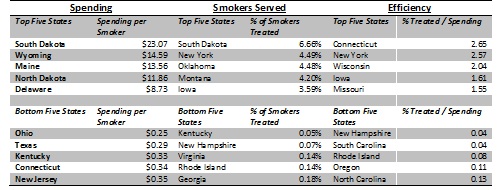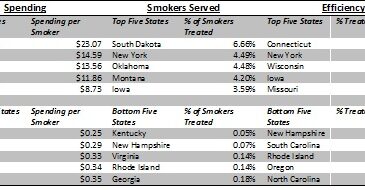States and the federal government have enacted public policies that assist with smoking cessation. A popular line of treatment is over-the-phone counseling via quitline. Quitlines can and often do serve as the first and sometimes the only line of help for smokers who want to quit. Since 2004, every state in the U.S., the District of Columbia, and Puerto Rico has operated a tobacco cessation quitline (American Lung Association, 2011). This week’s ASHES focuses on these state quitlines by examining data presented in the American Lung Association’s State of Tobacco Control Report (2011).
Methods
- The American Lung Association’s State of Tobacco Control Report (2011) provides information at the state level about the following quitline statistics:
1. Dollars spent, per smoker, on quitlines;
2. percentage of all smokers who receive treatment via the quitlines
- We calculated an additional variable, quitline cost effectiveness, operationalized as % of smokers who received treatment / money spent per smoker
- If states spend large amounts of money but serve few of their smokers, their score on this variable will be low; if, conversely, they spend less money but serve more of their smokers, their score will be high.
Results
- There was a highly significant correlation (r = .667, p < .001), between the money spent per smoker, and the percentage of smokers who received treatment via quitline counseling.
- The five states that spent the most money per smoker were South Dakota, Wyoming, Maine, North Dakota, and Delaware.
- The five states that served the greatest number of smokers were South Dakota, New York, Oklahoma, Montana, and Iowa.
- The five most “cost effective” states (% served / spending) were Connecticut, New York, Wisconsin, Iowa, and Missouri. There was little overlap between the highest-spending states and the most cost-efficient states.

Figure. State Spending on Quitlines and Smokers Served. Click image to enlarge.
Limitations
- This is a correlational study; therefore it cannot inform us about the causal connection between spending and treatment.
- The fact that more smokers are receiving treatment in a given state does not tell us about the quality of that treatment. Greater dollars spent might equate to better care, not just more care.
Discussion
Though dollars spent was positively associated with treatment engagement, states that were most cost effective in their quitline treatment programs were not the same states that reported the most spending. The CDC and the North American Quitline Consortium report that quitline services are not receiving the optimal rate of funding ($10.53 per tobacco user) to provide best practice-level services. However, appeals for increased funding must be considered carefully. Throwing more money into state-funded quitlines might not necessarily be predictive of better overall treatment efficiency.
— Kat Belkin and Sarah Nelson
References
American Lung Association (2011). Helping smokers quit: Tobacco cessation coverage 2011. Accessible at http://www.lungusa.org/assets/documents/publications/smoking-cessation/helping-smokers-quit-2011.pdf
What do you think? Please use the comment link below to provide feedback on this article.





Noah January 11, 2012
Excellent research on efficiency of money spent per smoker. To get more for your buck in treating smoking addiction is a must.
thanks